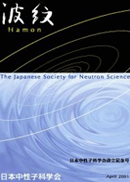
- 4 号 p. 130-
- 3 号 p. 84-
- 2 号 p. 38-
- 1 号 p. 2-
- |<
- <
- 1
- >
- >|
-
矢野 直峰, 伏信 進矢2024 年34 巻4 号 p. 130-133
発行日: 2024/11/10
公開日: 2025/12/01
ジャーナル フリーGum arabic is widely used as an emulsion stabilizer and edible coating and consists of a complex carbohydrate moiety with a rhamnosyl-glucuronate group capping the non-reducing ends. To determine the specific reaction mechanism based on its hydrogen-containing enzyme structure, we performed joint X-ray/neutron crystallography of L-rhamnose-α-1,4-D-glucuronate lyase from Fusarium oxysporum. Large crystals were grown in the presence of L-rhamnose (a reaction product), and neutron and X-ray diffraction datasets were collected at room temperature at 1.80 and 1.25 Å resolutions, respectively. The active site contained L-rhamnose and acetate, the latter being a partial analog of glucuronate. Incomplete H/D exchange between Arg166 and acetate suggested that a strong salt-bridge interaction was maintained. Doubly deuterated His105 and deuterated Tyr150 supported the interaction between Arg166 and the acetate. The unique hydrogen-rich environment functions as a charge neutralizer for glucuronate and stabilizes the oxyanion intermediate. The NE2 atom of His85 was deprotonated and formed a hydrogen bond with the deuterated O1 hydroxy of L-rhamnose, indicating the function of His85 as the base/acid catalyst for bond cleavage via β-elimination. Asp83 functions as a pivot between the two catalytic histidine residues by bridging them. This His–His–Asp structural motif is conserved in the PL 24, 25, and 42 families.
抄録全体を表示PDF形式でダウンロード (1209K) -
今 布咲子, 網塚 浩2024 年34 巻4 号 p. 134-138
発行日: 2024/11/10
公開日: 2025/12/01
ジャーナル フリーWe examined the antiferromagnetic (AFM) structure of UPt2Si2, which develops below TN = 34 K, using polarized and unpolarized neutron diffraction techniques. Previous studies report that this system undergoes the AFM order with the propagation vector Q = 0 and magnetic moments aligned along the c-axis. Notably, our recent resonant X-ray scattering (RXS) experiments revealed that this magnetic structure is modulated by the charge-density-wave (CDW) order, which is formed in one of the Pt layers with the propagation vector qCDW = (∼0.42, 0, 0) below ∼320 K. In this neutron scattering study, we observed the magnetic scattering contributions below TN at the superlattice reflections corresponding to qCDW. Our detailed analysis confirmed the presence of the transversal magnetic modulation in the AFM phase and quantified its amplitude to be 0.72(2) μB/U. These results indicate that the CDW causes the ordered magnetic moments to tilt by up to ~20° in the AFM phase, suggesting significant hybridization between the U 5f and Pt 5d electrons in this compound.
抄録全体を表示PDF形式でダウンロード (831K)
- |<
- <
- 1
- >
- >|